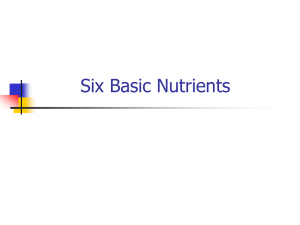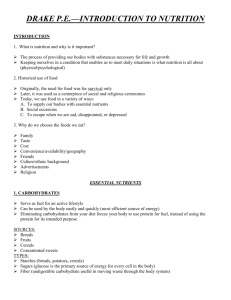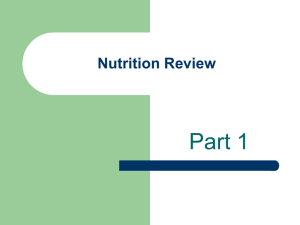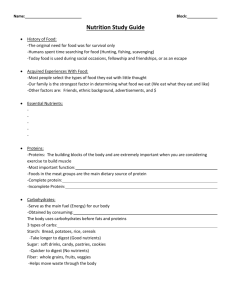Chapter 7: Nutrition for Life Unit 2: Health and Your
advertisement
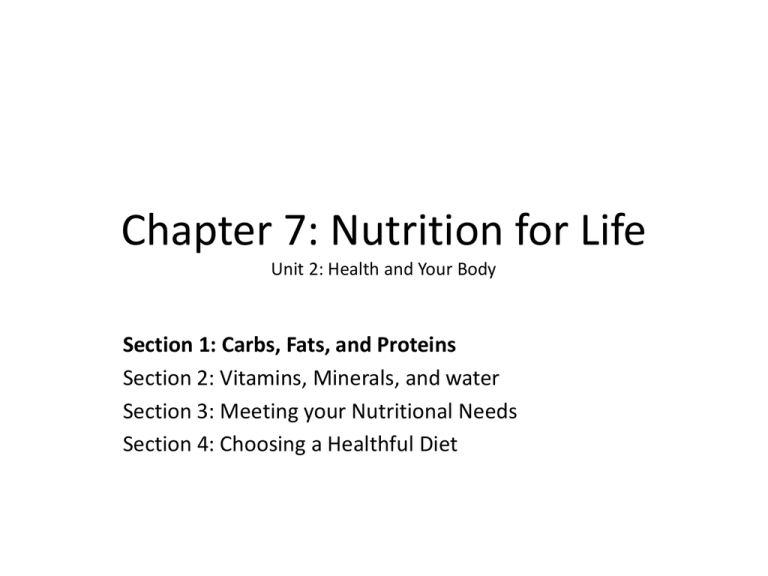
Chapter 7: Nutrition for Life Unit 2: Health and Your Body Section 1: Carbs, Fats, and Proteins Section 2: Vitamins, Minerals, and water Section 3: Meeting your Nutritional Needs Section 4: Choosing a Healthful Diet Do Now • What are your favorite foods? • Would you consider them to be healthy or nutritious? • How would you rate your eating habits, from 1 to 5 with 5 being the highest. • Please explain why. Objectives • Name the 6 classes of nutrients • Identify the functions and food sources of carbohydrates, proteins, and fats. • Describe the need for enough fiber in your diet. • Identify one health disorder linked to high levels of saturated fats in the diet. • Describe how diet can influence health. Key Terms • • • • • Nutrition: Nutrient: Carbohydrate: Fat: Protein: What is Nutrition • Nutrition: the study of food. • Nutrients: substance in food that provides energy. Six Classes of Nutrients 1. Carbohydrate: Nutrient that provides energy (sugar, starch, fibers). 2. Fat: Stores energy in the body. 3. Protein: Amino acids that repair and build body structures such as muscles. 4. Vitamins: 5. Minerals: 6. Water: Balanced Diet Keeps You Healthy • Too little food: weight loss, poor growth, and possible death. • Too much food: Excess body fat, heart disease, high blood pressure, • Diseases caused by poor nutrition: Obesity, heart disease, osteoporosis, cancer, and diabetes. Carbohydrates Simple: Sugars Complex: Starches sugar Starch Fruit potatoes Milk Beans and peas Candy Grains such as rice soda Corn Cakes bread NO NUTRIENTS in these foods CONTAINS NUTRIENTS Carbohydrates continued… • Glycogen: Quick energy reserve • Fiber: Can not be digested but is good for intestines and colon. Fats • Saturated Fat: Milk, butter, ice cream, – Leads to obesity • Unsaturated Fat: olive oil, canola oil, peanut oil, flower oil, soybean oil – Can protect from heart disease • Cholesterol: Found in animals. Forms on blood vessels and restricts blood flow. Proteins • Repairs the body and helps create new cells. • Complete Proteins: Meat, eggs, and dairy. • Incomplete Proteins: Beans, grains, and vegetables. • Both are necessary in a healthy diet. 10-35% of calories should come from proteins. Exit Slip: Unit 7. Sec 1 • • • • What are the 6 classes of nutrients? Define protein and provide 3 examples. Define Carbohydrate and provide 3 examples. Define fat and provide 2 examples. Chapter 7: Nutrition for Life Unit 2: Health and Your Body Section 1: Carbs, Fats, and Proteins Section 2: Vitamins, Minerals, and water Section 3: Meeting your Nutritional Needs Section 4: Choosing a Healthful Diet Do Now • Self-assess your drinking habits. – What do you drink the most? Soda, juice, water? How much water do you drink a day? How many glasses of water do you think are required a day? Objectives • Describe the functions and food sources of 7 Vitamins • Describe the functions and food sources of 7 minerals. • Identify the importance of drinking enough water every day. • Name 2 ways to increase your calcium intake. Key Terms • • • • Vitamin Mineral Nutrient Nutrient Deficiency Vitamins • Vitamins are a class of nutrients that contain carbon and are needed in small amounts. • 2 types – Fat Soluble Vitamins – Water Soluble Vitamins Fat-Soluble Vitamins Vitamin A D E K Foods that have it What it does Water-Soluble Vitamins Vitamin Foods that have it What it does Minerals • Are a class of nutrients that are chemical elements that are needed for certain processes, such as enzyme activity and bone formation. – Vitamins and Mineral Supplements – Sodium – Calcium – Iron Water • 60% of your body is made up of water. • Drink 8 glasses of water a day. Exit Slip: Unit2, Sec2 • What is a vitamin and what are the two types? • Which food has Vitamin A and how does it help your body? • What is a mineral? Provide 3 examples. • What percent of your body is made up of water and how many glasses of water should you drink a day?


